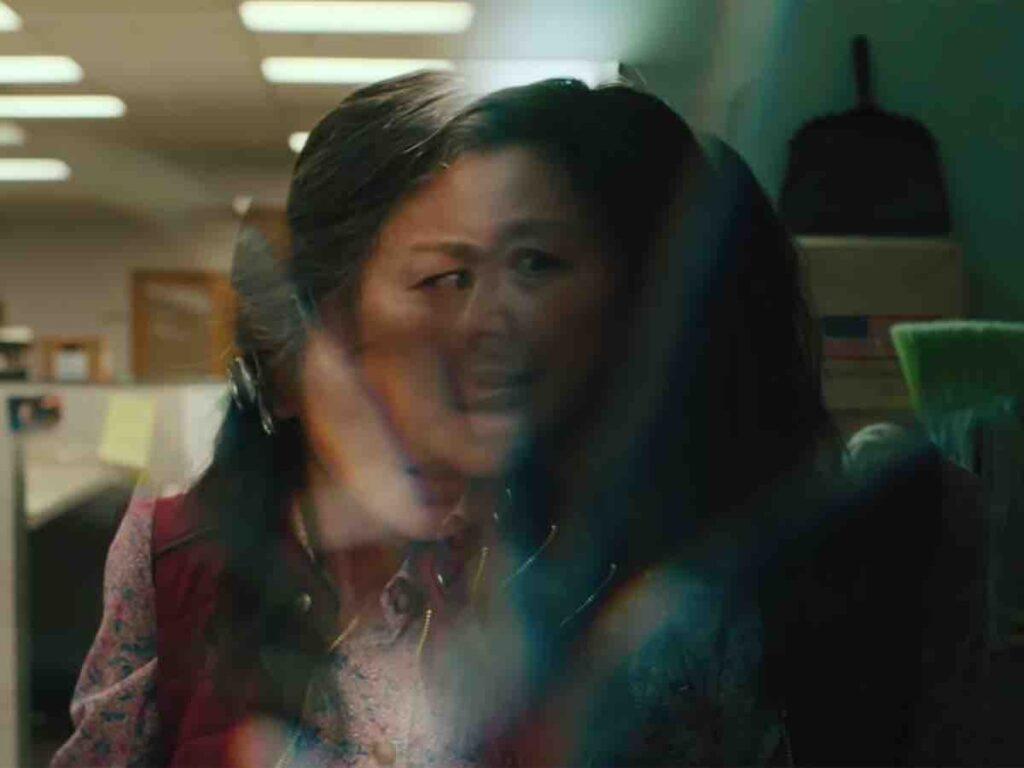Director duo Daniel Kwan and Daniel Scheinert’s multiple Oscar winning Everything Everywhere All At Once is an amusing, heartwarming sci-fi action adventure. The story revolves around a weary Asian American woman who is unable to settle her taxes that leaves her personal and professional life in a mess. It is also a pastiche of comedy and family drama, with deeper connotations that are difficult to grasp in first viewing. The pace of the storytelling alternates between thrilling and complexly structured moments and pays an intelligent homage to legendary directors like Stanley Kubrick and Wong Kar Wai.
WATCH: How To Write Great Dialogue
At times, the alternate timelines may appear jarring, but it’s an intriguing experience nonetheless, to traverse with the characters in these diverse spaces and witness how universal goodwill triumphs over the vices and difficulties of our lives.
The narrative structure is divided into three sections: Everything, Everywhere, and All At Once. Through these individual segments, the filmmaker introduces the audience to an array of situations that promise originality in storytelling and plenty of dramatic conflicts. The protagonist, Evelyn, a Chinese-American woman played by Michelle Yeoh, owns a low-profile laundromat with her husband, Waymond (Ke Huy Quan). She struggles to get along with her daughter Joy (Stephanie Hsu), who is in a homesexual relationship with an American-Mexican girl Becky (Tallie Medel) and doesn’t have the gall to reveal her daughter’s sexual identity to his father. Evelyn also looks after her old and feeble father, Gong Gong (James Hong).
On the work front, a difficult tax officer Deirdre Beaubeirdra (Jamie Lee Curtis) is auditing the laundromat’s expenditures and is upset over Evelyn‘s attempts to claim deductions for a karaoke machine for the laundromat’s community party nights. Thanks to Deirdre, if Evelyn doesn’t submit the bills, her laundromat is at the risk of being seized by the authorities. To add to her woes, Waymond wants a divorce from Evelyn.
The distraught Evelyn imagines that in another life she might’ve been a singer, a chef, or a movie star, and that sets off a madcap odyssey into a variety of alternate realities. The plot emphasizes that our every decision, small or significant, will have consequences in the future. This becomes the thematic concern of the film as Waymond informs Evelyn, in the beginning, inside the elevator, that each choice we make establishes a new universe.
It takes unconventional thinking to make a multiverse action movie that also portrays a family drama with all its generational conflict and disappointment. The concept and execution are bold and creative, utilizing several visual, animated, and symbolic mediums. Every conflict between Jobu Tupaki, also played by Stephanie Hsu, and the superhero version of Evelyn serves as a parable for the universal rift between a mother and daughter.
As a daughter, Joy suffers from low self-esteem and motivation for failing to live up to her mother’s expectations. She is, in fact, the mirror image of her mother and has inherited her negative qualities. Thus, the bagel in the film becomes a representation of her dismal mindset. It’s her weapon for destroying the multiverse and is designed to drain our positive energy.
So in the end, when she decides to dive right into the bagel and surrender herself to its negative energy, Evelyn battles to steal her back. The act isn’t merely to display her superheroic power but is an involuntary gesture driven by a motherly instinct. It is also reflective of a morally righteous mother who must support her daughter and guide her on the right path.
Evelyn’s motherly sentiments are also evident in the scene where the mother and daughter are shown as rocks. Both converse silently as texts appear on the screen expressing their emotions. It reflects the reality that parents often share a difficult relationship with their children, and the challenges of communication form unending barriers. So, when Joy, as a stone, approaches the edge of the cliff and dives down, Evelyn follows her instinct and descends with her. In fact, this silent sequence raises the film’s cinematic language a notch.
On the other hand, the googly eyes used on numerous occasions in the film are used as symbols of positive thinking. It stands for Waymond‘s belief that even if life has no purpose, there’s room for happiness. When Evelyn puts it on her forehead at the end of the film, it represents that she is now a changed person and subscribes to the beliefs of her husband. Moreover, the technique of ‘verse jumping’ used by Evelyn is a symbolic means for her to amend all the wrong decisions she’s made in her life. In every alternate universe, she is shown to possess a skill or talent, which gives her an opportunity for revision.
The plot never deviates from its path of telling a straightforward story of marital strife, family strife, and the bonds of love. Though the sci-gi genre and the invigorating concept of a multiverse help draw viewers in, it’s the theme of compassion, faith, and forgiveness that captivates and keeps us hooked. Whichever decision we make in life, the film highlights that sometimes it won’t truly matter in the end. And how the Daniel brothers convey this idea is an extraordinarily fascinating cinematic experience.
Where to Watch: Amazon Prime




